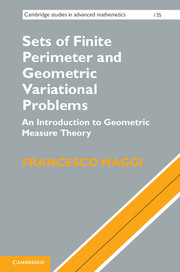Description
Sets of Finite Perimeter and Geometric Variational Problems
An Introduction to Geometric Measure Theory
Cambridge Studies in Advanced Mathematics Series
Author: Maggi Francesco
An engaging graduate-level introduction that bridges analysis and geometry. Suitable for self-study and a useful reference for researchers.
Language: English
Subject for Sets of Finite Perimeter and Geometric Variational Problems:
Approximative price 92.02 €
In Print (Delivery period: 14 days).
Add to cart
Publication date: 08-2012
476 p. · 16x22.9 cm · Hardback
476 p. · 16x22.9 cm · Hardback
Description
/li>Contents
/li>Biography
/li>
The marriage of analytic power to geometric intuition drives many of today's mathematical advances, yet books that build the connection from an elementary level remain scarce. This engaging introduction to geometric measure theory bridges analysis and geometry, taking readers from basic theory to some of the most celebrated results in modern analysis. The theory of sets of finite perimeter provides a simple and effective framework. Topics covered include existence, regularity, analysis of singularities, characterization and symmetry results for minimizers in geometric variational problems, starting from the basics about Hausdorff measures in Euclidean spaces and ending with complete proofs of the regularity of area-minimizing hypersurfaces up to singular sets of codimension 8. Explanatory pictures, detailed proofs, exercises and remarks providing heuristic motivation and summarizing difficult arguments make this graduate-level textbook suitable for self-study and also a useful reference for researchers. Readers require only undergraduate analysis and basic measure theory.
Part I. Radon Measures on Rn: 1. Outer measures; 2. Borel and Radon measures; 3. Hausdorff measures; 4. Radon measures and continuous functions; 5. Differentiation of Radon measures; 6. Two further applications of differentiation theory; 7. Lipschitz functions; 8. Area formula; 9. Gauss–Green theorem; 10. Rectifiable sets and blow-ups of Radon measures; 11. Tangential differentiability and the area formula; Part II. Sets of Finite Perimeter: 12. Sets of finite perimeter and the Direct Method; 13. The coarea formula and the approximation theorem; 14. The Euclidean isoperimetric problem; 15. Reduced boundary and De Giorgi's structure theorem; 16. Federer's theorem and comparison sets; 17. First and second variation of perimeter; 18. Slicing boundaries of sets of finite perimeter; 19. Equilibrium shapes of liquids and sessile drops; 20. Anisotropic surface energies; Part III. Regularity Theory and Analysis of Singularities: 21. (Λ, r0)-perimeter minimizers; 22. Excess and the height bound; 23. The Lipschitz approximation theorem; 24. The reverse Poincaré inequality; 25. Harmonic approximation and excess improvement; 26. Iteration, partial regularity, and singular sets; 27. Higher regularity theorems; 28. Analysis of singularities; Part IV. Minimizing Clusters: 29. Existence of minimizing clusters; 30. Regularity of minimizing clusters; References; Index.
Francesco Maggi is an Associate Professor at the University of Texas, Austin, USA.
© 2024 LAVOISIER S.A.S.



